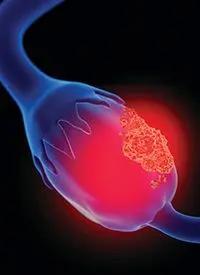GEN-1 Plus Neoadjuvant Chemo Appears Active, Safe in Advanced Ovarian Cancer
The addition of GEN-1 to standard-of-care neoadjuvant chemotherapy has shown preliminary safety and clinical activity and appears to have an impact on the tumor microenvironment in patients with advanced epithelial ovarian cancer.

The addition of the DNA-based interleukin-12 (IL-12) immunotherapy GEN-1 to standard-of-care neoadjuvant chemotherapy has shown preliminary safety and clinical activity and appears to have an impact on the tumor microenvironment in patients with advanced epithelial ovarian cancer, according to data from the phase 1 OVATION 1 trial (NCT02480374).1
Results, which were published in Clinical Cancer Research, showed that the combination was well tolerated, with no dose-limiting toxicities (DLTs) reported. Of the 14 evaluable patients, 85.7% (n = 12) achieved a radiological response prior to debulking; 2 patients experienced a complete response (CR) and 10 had a partial response (PR). Moreover, at the time of debulking, 9 patients were R0, and 1 patient achieved a pathological complete response (pCR).
Increased levels of IL-12 and interferon-g were seen in the peritoneal washings because of the treatment, as well as increased levels of myeloid dendritic cells and T effector memory cells in the peritoneal fluid. Additionally, elevated CD8-positive T cells and reduced immunosuppression were reported within the tumor microenvironment.
“As patients with advanced ovarian cancer have a poor prognosis, these data are particularly encouraging. We believe this publication will create additional awareness of the work we are doing to treat these patients and provide them with new hope,” Nicholas Borys, MD, chief medical officer of CelsionWhile, stated in a press release.2 “While we know that R0 resection scores are important to survival and that GEN-1 has exhibited impressive R0 scores, its ability to improve CRS is also compelling. Adding GEN-1 to standard neoadjuvant chemotherapy is safe, appears to be clinically active with translational data suggesting a positive impact on the tumor microenvironment.”
For patients with epithelial ovarian cancer, there remains an unmet need for treatments that not only improve survival outcomes, but also reduce the rate of disease recurrence. Immunotherapies have shown promise in this regard, as has been demonstrated by the immune activation these agents elicit through the production of antibodies or antitumor T-cell lymphocytes in primary tumors, ascites, and blood.
IL-12 has been associated with adaptive immune responses against cancer cells, and responses to the pluripotent cytokine have been demonstrated across cancer types. Moreover, treatment with GEN-1 has been shown to elicit durable local levels on IL-12, and in preclinical models, demonstrate promising safety and efficacy in patients with ovarian cancer. As such, investigators sought to examine the safety and efficacy of the agent in combination with carboplatin- and/or paclitaxel-based neoadjuvant chemotherapy in this patient population.
The study followed a standard 3+3 dose-escalation design and examined GEN-1 at the following 4 doses: 36 mg/m2, 47 mg/m2, 61 mg/m2, 79 mg/m2. The agent was given for a total of 8 weekly intraperitoneally infusions starting at cycle 1 week 2, and in combination with three 21-day cycles of carboplatin chemotherapy at a dose of 900 mg, and weekly paclitaxel at a dose of 80 mg/m2 for 9 weeks.
To be eligible for enrollment, patients had to have a histologically confirmed diagnosis of epithelial ovarian, fallopian tube, or primary peritoneal carcinoma with an epithelial cell type of either high-grade serous adenocarcinoma, endometrioid adenocarcinoma, undifferentiated carcinoma, clear cell adenocarcinoma, or mixed epithelial carcinoma. Patients also needed to be at least 18 years, with acceptable organ and neurological function, and an ECOG performance status of 0 to 2.
Those who had received prior treatment with GEN-1, or treatment with chemotherapy or radiotherapy for an abdominal or pelvic tumor were excluded.
Among the patients enrolled to the study, the median age was 63 years (range, 48-79), and the majority were White (83%), had stage IIIC disease (67%), and had high-grade, serous adenocarcinoma (95%).
Additional data from the study showed that the time to treatment failure was 18.4 months in the intent-to-treat population (n = 18) vs 21 months in the per-protocol population (n = 14).
Among the high-dose cohorts (61 mg/m2 and 79 mg/m2), the overall response rate (ORR) with this approach was 100%; in the low-dose cohorts (36 mg/m2 and 47 mg/m2), the ORR was 67%. Moreover, the R0 resection rate was 88% for the high-dose cohorts vs 33% for the low-dose cohorts.
Regarding safety, most adverse effects (AEs) were grade 1 or 2 in severity, and the most common were nausea (67%), fatigue (53%), abdominal pain/cramping (40%), anorexia (40%), diarrhea (40%), and vomiting (40%). The most common grade 3 and 4 AEs included nausea (n = 2) and fatigue (n = 4).
References
- Thaker PH, Bradley WH, Leath CA, et al. GEN-1 in combination with neoadjuvant chemotherapy for patients with advanced epithelial ovarian cancer: a phase I dose-escalation study. Clin Cancer Res. Published online July 29, 2021. doi:10.1158/1078-0432.CCR-21-0360
- Results of Celsion’s OVATION 1 study with GEN-1 in patients with advanced ovarian cancer published in the Journal of Clinical Cancer Research. News Release. Celsion CORP. July 29, 2021. Accessed July 29, 2021. https://bit.ly/3i7OWAe



